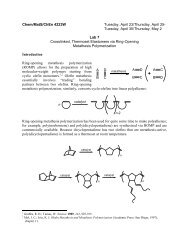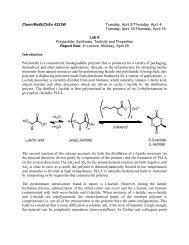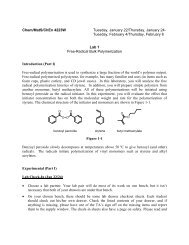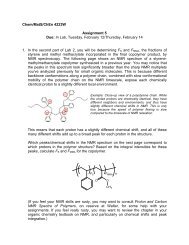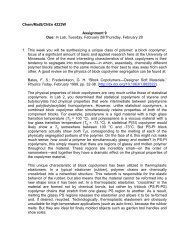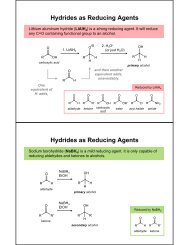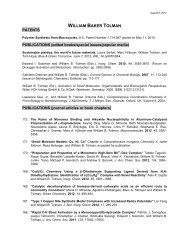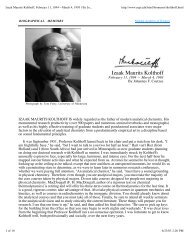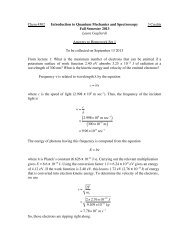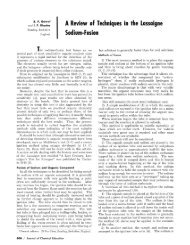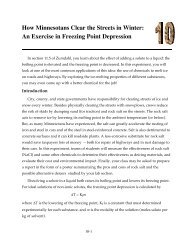Ion-Selective Electrodes With Ionophore-Doped Sensing Membranes
Ion-Selective Electrodes With Ionophore-Doped Sensing Membranes
Ion-Selective Electrodes With Ionophore-Doped Sensing Membranes
You also want an ePaper? Increase the reach of your titles
YUMPU automatically turns print PDFs into web optimized ePapers that Google loves.
<strong>Ion</strong>ophore-doped sensing membranes 2571<br />
C 18 H 37 O<br />
O<br />
H<br />
+ HSO 3<br />
−<br />
C 18 H 37 O<br />
OH<br />
H<br />
SO 3<br />
−<br />
O<br />
O<br />
Figure 29<br />
Covalent binding of HSO 3 − to a benzaldehyde ionophore.<br />
4.7 <strong>Ion</strong>ophore-based ion-selective electrodes for<br />
organic ions<br />
One approach to the detection of electrically neutral organic<br />
analytes is based on the use of enzymes that catalyze<br />
the formation of an ion that can be detected potentiometrically,<br />
as discussed in Section 3.1.7. The direct detection<br />
of electrically neutral organic species with ISEs is<br />
not possible since the transfer of these species across<br />
the interface of an aqueous sample into an ISE membrane<br />
does not involve the transfer of an electric charge<br />
across this interface. However, electrically neutral species<br />
can affect the phase boundary potential indirectly. Several<br />
studies have shown how alcohols, carboxylic acids,<br />
and oligoethers (including several surfactants of this type)<br />
cause a potentiometric response upon distribution from<br />
the aqueous sample into ionophore-free cation-exchanger<br />
4, 153, 154<br />
membranes loaded with metal cations. This can<br />
be explained by specific binding of these electrically<br />
neutral, hydrophobic organic species in the ISE membrane<br />
to the metal cations, which lowers the activity<br />
of the metal cation in the sensing membrane and<br />
causes a change in the phase boundary potential at the<br />
sample–membrane interface (2). An analogous principle<br />
has also been described for the detection of phenols. 155<br />
While this approach does not involve the use of an<br />
ionophore, the interaction of the metal cation with these<br />
organic substrates falls undoubtedly within the field of<br />
host–guest chemistry.<br />
A much larger number of ISEs have been proposed<br />
for the detection of electrically charged organic analytes.<br />
Many of these ISEs fall into the category of ionophorefree<br />
ion-exchanger electrodes, and while they do often<br />
exhibit high selectivities for fairly hydrophobic organic<br />
ions over many inorganic ions, they are from the point<br />
of view of supramolecular chemistry not of interest. However,<br />
a number of ionophores have been used to prepare<br />
ISEs for the detection of organic ions. Some of<br />
these ionophores have structures that are quite similar<br />
to those of ionophores used in ISEs for inorganic ions.<br />
These include, for example, crown ethers and calixarenes<br />
used for the detection of protonated amines and amino<br />
acid esters, and metalloporphyrins for the detection of<br />
anions. 4 Recent examples include, for example, tin(IV)<br />
and zirconium (IV) porphyrins for the monotopic recognition<br />
of phthalate (phthalate) 156 and citrate (citrate), 157<br />
respectively.<br />
COO −<br />
COO −<br />
Phthalate<br />
− COO<br />
COO −<br />
HO COO −<br />
Citrate<br />
Other ionophores have been specifically designed for<br />
the selective recognition of organic analytes. Among the<br />
recent particularly unique examples are receptors with three<br />
trifluoroacetophenone groups for the recognition of phenylalanine<br />
(phenylalanine-I) 158 and sophisticated hydrogenbonding<br />
hosts for nucleobases, such as the adenosine 5 ′ -<br />
monophosphate binding receptor AMP-I. 159<br />
A special feature of organic ions is that many of<br />
them are optically active. Since the complexes of a chiral<br />
ionophore with two enantiomers are diastereomers,<br />
their formation energies differ from one another and<br />
permit the preparation of enantioselective ISEs. While<br />
already recognized back in the 1970s, 4 examples for<br />
this concept continue to be reported on a regular basis.<br />
The organic chemist will recognize in ionophores used<br />
for this purpose structural elements familiar from enantioselective<br />
catalysis. A typical recent example is the<br />
popular binaphthyl group of phenylglycineOCH 3 -I,<br />
a receptor that has been used for the enantioselective<br />
potentiometric detection of phenylglycine methyl<br />
ester. 160<br />
In summary, considerable efforts have been spent<br />
to show the feasibility of ISEs for organic analytes.<br />
While some authors used ionophore-based ISEs to measure<br />
organic target analytes in relatively simple samples<br />
such as drug tablets that contained besides the<br />
analyte only hydrophilic inorganic ions, only very few<br />
reports exist on the use of such electrodes for measurements<br />
in more complex samples such as blood, saliva, or<br />
milk.



